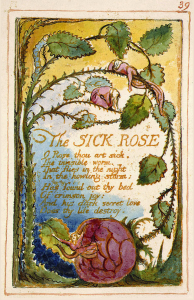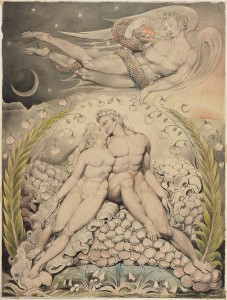I have been confused about the main idea of this course, which I have not really started to ponder until our first writing assignment, when I was viewing Blake’s The Sick Rose. The delightful analysis we did in class made me think about the specific integration of symbolic elements through which Blake was able to deliver a comprehensive portrayal of the idea of procreation and the resulting transition from innocence to experience. The inclusion of the changing worm on top of the ecstatic/suffering female figure, the dying flower on the ground, using a moth as a reference to a male phallus, all such elements and more are carefully and purposefully organized in a scene that is intended to carry the viewer’s gaze from one point to the next to highlight the main idea behind the poem. This astute representation is one that allows viewers to understand the symbolic nature of pictures because of its conceptual simplicity, it integrates elements about the nature of life that everybody can relate to.
As for the relatively poor technique of the print, I incline to attribute that, like Prof. Janelle said in class, to Blake’s purposeful integration of image and text. In Adam and Eve, it is clear that Blake was a versed artist, which directs one to think that his style in The Sick Rose must have been employed to serve a purpose related to meaning. Possibly, Blake could have produced the print with such a technique because of an awareness that it is impossible to fully embody a universal nature. This idea stems out of my belief that illumination is primarily non-visual, I am not sure if this hypothesis would be reasonable given Blake’s artistry in his other works before or after doing The Sick Rose.
In spite of my grounded belief that concepts cannot be visually illuminated, I believe that pictures urge people to think deeper by confronting them with piercing questions, it occurs to me this might be the result of our visually-dependent culture, but I have not given that much thought or study. The juxtaposition of the print with the poem “speaks” effectively of the nature of visual pictures, a metapicture.


